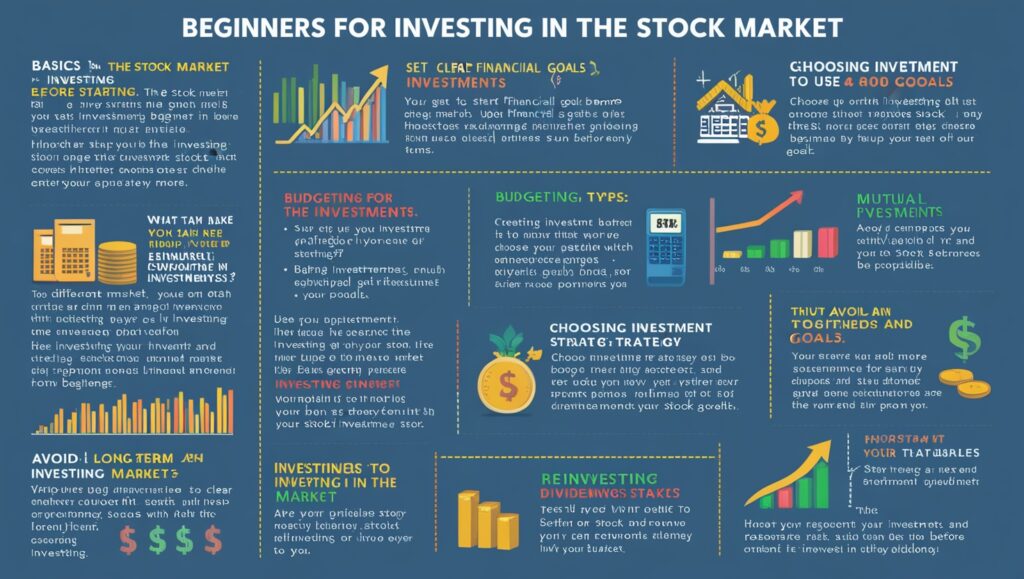A Beginners Guide to Stock Market Investment
Investing in the stock market can seem intimidating for beginners, but with the right knowledge and approach, it’s a powerful tool for growing wealth and achieving financial goals. This guide breaks down the essentials of stock market investing, helping you start with confidence and avoid common pitfalls.
1. Understand the Basics of the Stock Market
The stock market is a platform where investors buy and sell shares of publicly traded companies. When you buy a stock, you’re purchasing a small piece of that company. If the company does well, the stock price typically increases, allowing you to sell at a profit. However, if the company’s performance drops, so can the stock’s value. Stock market returns are not guaranteed, so it’s important to understand that all investments carry some level of risk.
2. Set Clear Financial Goals
Before diving in, outline your investment goals. Are you investing for long-term wealth, saving for a down payment, or building a retirement fund? Your goals will shape your strategy and determine factors like how much risk you’re willing to take and how long you intend to keep your investments. Knowing what you’re working towards makes it easier to select the right investments and stay committed to your plan.
3. Learn the Different Types of Investments
There are various types of investments available in the stock market:
- Stocks: Individual shares of companies that allow you to benefit from a company’s growth. They offer high potential returns but come with higher risk.
- Bonds: These are loans you give to companies or governments in exchange for interest payments over time. Bonds are typically lower risk than stocks.
- Mutual Funds: Pooled investments that allow you to buy a variety of stocks and bonds in one fund. They offer diversification, reducing the risk of individual stocks.
- Exchange-Traded Funds (ETFs): Similar to mutual funds, ETFs pool a variety of assets but are traded like stocks on an exchange, often with lower fees.
Diversifying among these types can reduce risk while allowing you to benefit from different asset classes.
4. Decide on a Budget for Investing
Start with an amount you’re comfortable with, understanding that stock market investments should ideally be money you won’t need in the short term. Many experts recommend investing 10-15% of your monthly income if possible, but even small amounts can grow over time. The important part is to start. You don’t need a fortune to begin investing; many platforms allow you to invest with minimal amounts.
5. Choose an Investment Strategy
There are several strategies that investors use based on their goals and risk tolerance. Here are a few common ones:
- Buy and Hold: This is a long-term strategy where you buy stocks or ETFs and hold onto them, allowing them to grow over time. This approach requires patience but reduces the impact of short-term market fluctuations.
- Dollar-Cost Averaging: With this strategy, you invest a set amount at regular intervals, regardless of the market’s ups and downs. This approach helps reduce the impact of market volatility and avoids the pressure of “timing the market.”
- Growth vs. Value Investing: Growth investors look for high-growth companies expected to increase earnings, while value investors look for undervalued stocks they believe will rise over time. Choose a style that aligns with your goals.
6. Research Before You Invest
One of the most important steps is to research companies and investment options. Look into a company’s financial health, earnings history, and industry prospects before buying its stock. For mutual funds and ETFs, review the fund’s past performance, fees, and the assets it includes. Many investment platforms provide insights and tools to help with research, so take advantage of these resources.
7. Consider Working with a Financial Advisor
If you’re unsure where to start or how to make the best decisions, consulting a financial advisor can be helpful. They can provide guidance based on your goals and risk tolerance, helping you avoid common mistakes and craft a tailored strategy. Many advisors offer services for beginners and can guide you through the first steps of investing.
8. Avoid Common Pitfalls
New investors often make a few common mistakes. Here’s what to watch out for:
- Emotional Investing: Avoid making investment decisions based on emotions. Fear and greed can cloud your judgment, leading to impulsive decisions.
- Trying to Time the Market: Predicting market highs and lows is extremely difficult. Instead, stick with a consistent strategy, like dollar-cost averaging, that works in any market condition.
- Overlooking Fees: Investment platforms and funds often charge fees that can reduce your returns over time. Look for low-cost options, especially if you plan to hold investments long-term.
9. Keep a Long-Term Perspective
The stock market tends to grow over the long term, despite short-term fluctuations. A long-term mindset helps you stay focused during downturns, knowing that temporary losses are a normal part of investing. Regularly reviewing your portfolio and adjusting as needed is essential, but avoid panicking over day-to-day changes.
10. Reinvest Your Dividends
When you earn dividends from your investments, consider reinvesting them rather than cashing out. Reinvesting allows you to buy more shares, which compounds your returns over time. Many platforms offer automatic dividend reinvestment, making it easy to grow your investment passively.
Final Thoughts
Stock market investing is a journey, not a get-rich-quick scheme. By setting clear goals, doing thorough research, and maintaining a long-term perspective, you can build a solid investment portfolio that grows with you over time. Remember, every successful investor started as a beginner—take small, informed steps, and watch your financial confidence grow along with your wealth.

